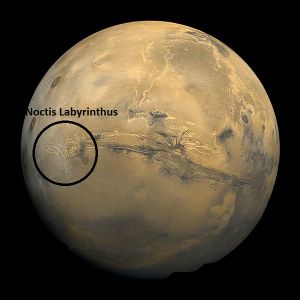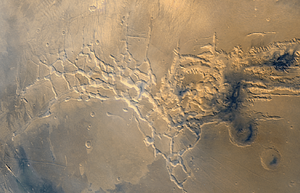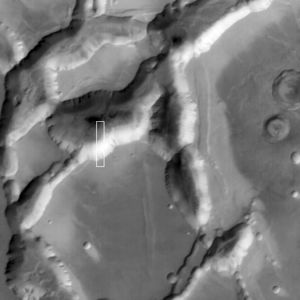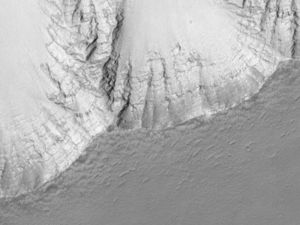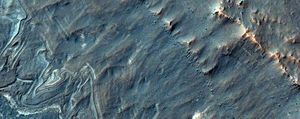Difference between revisions of "Noctis Labyrinthus"
(added info and ref) |
m |
||
| Line 11: | Line 11: | ||
[[Image:Noctis Labyrinthusmgs.jpg |thumb|center|px|Close view of Noctis Labyrinthus]] | [[Image:Noctis Labyrinthusmgs.jpg |thumb|center|px|Close view of Noctis Labyrinthus]] | ||
| − | Research from 2009 found a variety of minerals, including clays, sulfates, and hydrated silicas, in some of the layers.<ref> | + | Research from 2009 found a variety of minerals, including clays, sulfates, and hydrated silicas, in some of the layers.<ref>http://www.sciencedaily.com/releases/2009/12//091216205910.htm |title=Trough deposits on Mars point to complex hydrologic past |publisher=Sciencedaily.com |date=2009-12-17 |accessdate=2013-07-16 |deadurl=yes |archiveurl=https://web.archive.org/web/20131018010626/http://www.sciencedaily.com/releases/2009/12//091216205910.htm |archivedate=2013-10-18 |df= }}</ref> These minerals are associated with water. The water may have been from a body of water or may have come from groundwater. Since water had to be involved in their formation, evidence of ancient or existing life may be found there. |
[[Image:Noctislabyrinthus49297 1715layersclosenorth.jpg |thumb|center|px|Close view of Noctis Labyrinthus with HiRISE]] | [[Image:Noctislabyrinthus49297 1715layersclosenorth.jpg |thumb|center|px|Close view of Noctis Labyrinthus with HiRISE]] | ||
[[Image: NoctislabESP 027592 1685close.jpg |thumb|left|px|Close view of layers on floor of Noctis Labyrinthus with HiRISE]] | [[Image: NoctislabESP 027592 1685close.jpg |thumb|left|px|Close view of layers on floor of Noctis Labyrinthus with HiRISE]] | ||
Revision as of 09:07, 12 February 2018
Noctis Labyrinthus is a group of intersecting canyons that lies at the western end of Valles Marineris. It is in the Phoenicis Laus quadrangle. The center coordinates of Noctis Labyrinthus are 7.0 S and 102.2 W. The canyons of this feature are faults known as grabens. Grabens happen when a center section drops lower than sections on either side.
Discovered by Mariner 9, the name "Noctis Labyrinthus," means "the labyrinth of the night."
Research from 2009 found a variety of minerals, including clays, sulfates, and hydrated silicas, in some of the layers.[1] These minerals are associated with water. The water may have been from a body of water or may have come from groundwater. Since water had to be involved in their formation, evidence of ancient or existing life may be found there.
- ↑ http://www.sciencedaily.com/releases/2009/12//091216205910.htm |title=Trough deposits on Mars point to complex hydrologic past |publisher=Sciencedaily.com |date=2009-12-17 |accessdate=2013-07-16 |deadurl=yes |archiveurl=https://web.archive.org/web/20131018010626/http://www.sciencedaily.com/releases/2009/12//091216205910.htm |archivedate=2013-10-18 |df= }}
